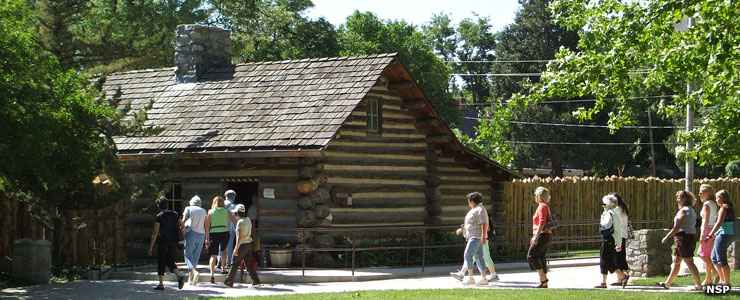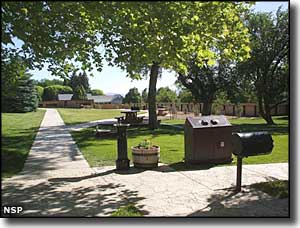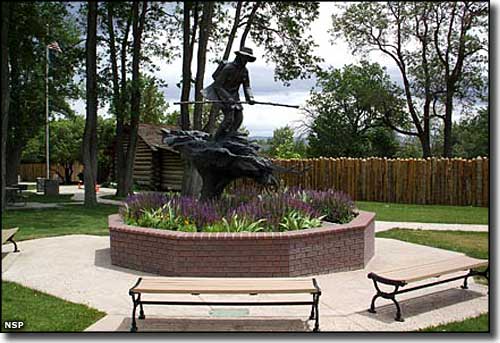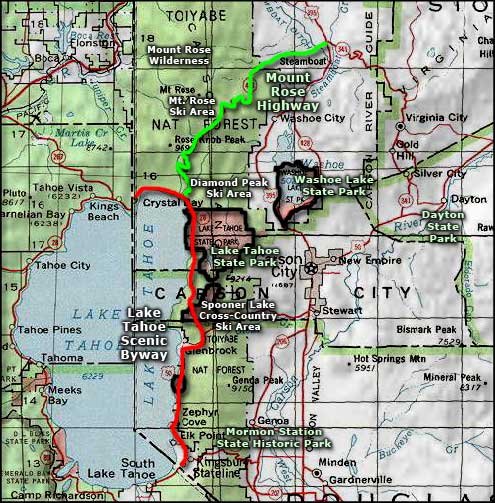Mormon Station State Historic Park

The museum at Mormon Station State Historic Park
- Flush Restrooms
- Picnicking
- Group Picnicking
- Visitor Center
- Historic Sites
Located 12 miles south of Carson City in Genoa, Mormon Station was Nevada's first permanent non-native settlement. While the original trading post was built in 1851, a replica now houses a small museum filled with artifacts and exhibits of the early pioneer days. While the museum charges a minimal fee ($1 per person for ages 12 and up), the stockade area is free to the public for self-guided tours. Under the large shade trees you'll find grills and picnic tables. There is a group use pavilion too, but reservations are required for its use and the parking is limited. Nearby is the Dangberg Home Ranch Historic Park.
The original Trading Station was established as a temporary station in 1850 by two former members of the Mormon Battalion, Abner Blackburn and Hampton Beatie. The Mormon Battalion had passed through this area as they headed to Utah after being released from the Army in California at the end of the Mexican War in 1848. This particular route of the Emigrant Trail had first been described by John C. Fremont after Kit Carson and John Walker guided his expedition to California through the area in 1845.
Beatie and Blackburn were employed by John Reese, a prominent businessman/merchant in Salt Lake City. On their return to Utah in the fall of 1850, they told stories of the beauty of this area on the western side of Carson Valley. In the spring of 1851, Reese and his nephew, Stephen Kinsey, packed up a wagon train and set out for Carson Valley. They built a permanent trading post about a mile south of the temporary site. By the time they opened for business, there was a livery stable, blacksmith shop and flour and saw mills nearby. They named the place "Reese's Station" and shortly set up a "squatter's government." The Utah Territorial Legislature organized the area as Carson County, Utah in 1854 and Mormon Apostle Orson Hyde was dispatched from Salt Lake to serve as probate judge and spiritual head of the community. When Hyde arrived, he saw fit to change the name of the site to "Genoa" (after Genoa, Italy) and established Genoa as the county seat. Then most of the Mormon settlers were recalled to Utah in 1857 to defend Salt Lake City from the US Army...

Genoa was the site of a Pony Express station in 1860-61, then Congress created the Territory of Nevada and removed the property from the jurisdiction of Utah. James Nye was appointed Governor of the territory and he established the territorial capital at Carson City. Valuable mineral strikes were occurring all over the area and Genoa served as an important freight and passenger center as one of the primary routes to-and-from California passed right through town. Nevada became the 36th state in 1864, then the Central Pacific Railroad was built across Nevada in 1867-68 to connect with the Union Pacific Railroad near Promontory Point in Utah in 1869. The railroad passed well to the north of Genoa and from that time on, the importance of the Genoa area declined. The county seat was moved from Genoa to Minden in 1916.
Today, Genoa is a quaint little town displaying a rich history of the early days of settlement and mineral discoveries in Nevada. The town offers several bed and breakfasts, gift and antique stores, excellent restaurants and access to a variety of recreational activities in the surrounding area including access to Inyo National Forest and the Sierra Nevada Mountains.
The museum at Mormon Station State Historic Park is open daily Thursday through Sunday from mid-May through mid-October, 10:00 AM to 4:00 PM. The rest of the property is day use only and has no fees attached. Summer months see several historical presentations and other interpretive programs on the schedule.

The memorial to Snowshoe Thompson
